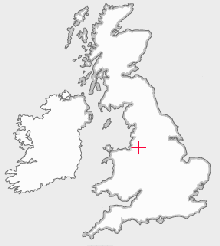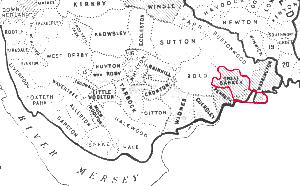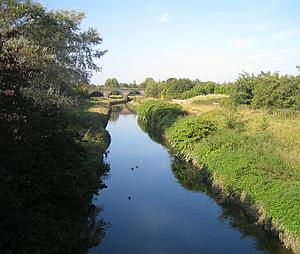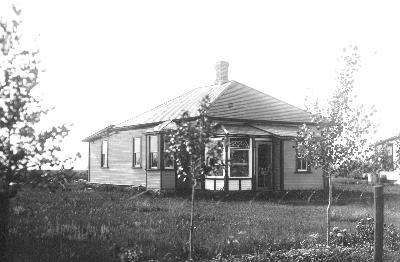|
The name Jordan de Sankey, cleric, appears as a witness on several charters during the 13th and
14th century. The earliest, about 1250, was a grant from William le Boteler to Henry son of
Henry de Sonky; it was witnessed by Jordan and no fewer than eleven others. William had good
reason to be cautious when dealing with the Sankeys, it seems, for in 1294 one Robert de Sankey
actually sued him and won, nominally over a patch of land barely large enough for a radish
patch. Something much larger must have actually been at stake, for, as Beamont puts it, it was a
bold thing in that age for a small man to sue a great one at law.
By the 1500's, the Sankey arms were emblazoned in stained glass at Warrington Church - the 1st
and 4th quarters were "argent on a bend sable three salmon of the field" - three white fish on a
black diagonal band on a white shield. About this time, one Peter Sankey lived in Leebotwold
Shropshire and came into a good deal of land, most likely through inheritance from a
grandmother Eynes. He obtained a B.A. from Oxford in 1570, became an M.A. in 1574 and later
a Fellow of All Souls. He married Elizabeth Eaton (there are many Sankey-Eaton marriages
in Daresbury Cheshire and neighbouring parishes), and was vicar of Baschurch and of Wem,
Shropshire. To go with his new-found status, Peter began using arms differenced (modified
slightly to denote a branch of the family) from those in Warrington, "or a bend sable three
salmon" - three fish of natural colour on a black band on a yellow shield. If he officially
registered them, the records have been lost. However his will and that of his wife still exist,
although despite all my efforts I've been unable to obtain a copy or transcript of them.
Peter's son Richard became rector of Hodnet Shropshire in 1615 and Richard's son Jerome (also known by
the Latin forms Hieronymus and Hierome), was also a Fellow of All Soul's, Oxford, a proctor of the
University, later MP for Tipperary, then Marlborough, and finally Woodstock, and was knighted by
Cromwell for slaughtering the Irish and collecting taxes from the survivors. (The History of
the Down Survey 1656-1666 notes: "Sir Hierome Sankey, who having been lately knighted, they knew
longed for some adventure to goe uppon." There is a fascinating view
of his relationship with
Cromwell in A History of the County of Dublin, F.E.Ball, 1920, under The Parish of Finglas.) By this
time, the Warrington arms had lapsed with no heir, so Sir Jerome obtained an official grant of them.
It was common in early times for coats of arms to be a word play on the owner's name, and this
tradition is upheld nobly with the bilingual pun "sancta clavis coeli fides" - the holy key to
heaven is faith. This may be the origin of the conceit claimed by Best-Gardner, that
the family descends from St.Peter to whom Jesus gave the holy keys of His Church.
Jerome had no children, and upon his death his estate passed to his nephew Richard, Governor of
the Isle of Man, my direct ancestor. From then until 1878, my Sankey ancestors resided in
Ireland. The Irish family seat from 1723 to 1920 was called Coolmore; it was near Fethard Tipperary.
In the Irish tradition, arms are a symbol (trademark, if you will) of a family, not just of an individual -
Burke's "General Armory" (1984) notes use in Brookeborough Fermanagh (my
great-grand-parents), Sankeystown and Newtown in King's Co. (Offaly today), St.Johnstown and
Coolmore Tipperary, Oaklands Wexford, Tenelick Longford, and Dublin. So, any
male-line descendant of Richard named Sankey may continue this tradition, as I do. (It may not
have been historically restricted to male-line either: Ann Shaw, the sister of Jerome, used them.)
Matthew Henry Sankey was probably born at Modeshill Tipperary. Along with his three brothers he
joined the army, but was apparently invalided out (two of his brothers became lt.generals, the
other a major). Joining the service of Lord Brooke
at Colebrooke Fermanagh, Matthew became agent for an absentee landlord and justice of the
peace. There were, therefore, two possible reasons why he was
shot in 1876 while walking up his garden path. Threats were also made by the group that killed
him against his wife Mehetabel and their children. She fled to Kingstown (near Dublin) with the
family silver, most of her children, and a bodyguard. However, my grandfather Charles, 13 at the
time, was taken under the wing of his uncle William Sankey, a general then serving in
Darmstadt, Germany. It was with his uncle that grandfather decided to become a merchant seaman;
he trained at the H.M.S.Conway at Rock Ferry on the Mersey and earned his certificate for
Navigation and Seamanship.
My aunt Mabel found the baptism records of my grandfather and all his siblings in the
300-year-old registers of the parish of Aghavea. The only public memorial to my
great-grandfather, however, is located on the Colebrooke estate - a 2500 kg bell for the
church there, which my parents and I saw in 1965. In the entry is a plaque which reads:
The bell in this Church was
Presented by the Colebrooke & Ashbrooke Families
in affectionate remembrance of their deeply lamented friend
Matthew H.Sankey Esq
who was for upwards of 20 years agent to the
Colebrooke Estate
Died 18th February, 1876.
The bell itself is inscribed :
J. MURPHY FOUNDER DUBLIN 1877
IN MEMORY OF MATHEW H.SANKEY DIED FEB.1876.
Great-grandmother Mehetabel left Kingstown in 1878 for Toronto, via New York, and was
involved somehow with property on Toronto Island which was sold at considerable profit. By the
April 1881 census she, and all her children except Henry and my grandfather, were living at 71
Wellington Place. The 1882 and 1883 Toronto City Directories record a move to 107 Baldwin St.
Her sons Richard and Edward had built a house near Turtle Mountain, in what was then called
the South Western Extension of Manitoba, and are also listed there in the census. Mehetabel
joined them in 1883, travelling by train via Chicago and Minnesota to Winnipeg, thence by wagon
to Turtle Mountain. (The CPR did not reach the area until 1899.) Great-uncle Villiers, who had
qualified as an Ontario surveyor, remained in Toronto; Henry seems to have gone to California
from New York. Great aunt May must have met William Ponton before the census, for their first
child was born in Belleville, September 1881.
Grandfather wrote of his travels in 1944 in a letter to his daughter Nora Zurcher. He stayed
behind in Kingstown when his mother left, then in May 1879 joined the barque 'Fantasie'
(originally the ship 'Eliza Shaw') at London, to take a load of goods to Sydney Australia, then
coal to Shanghai China, rice to Canton, finally Cassia oil back to London. There, in May 1880,
he joined the famous British ship the 'Cutty Sark' to take a
load of Welsh coal to Japan. The life of a sailor on fast sailing ships was no picnic at the
best of times, but the incredible events of grandfather's next
two years occupy an entire chapter in "The Log of the Cutty Sark" (Basil Lubbock, 1924).
His daughter Ethel Tillenius wrote it up for the official opening of the ship in her dry
dock at Greenwich; it also formed the base of Joseph Conrad's "Lord Jim". A mate so brutal
the London crew deserted at first port leaving only the bound apprentices; a superb
captain who drove his ship just short of 2000 km in 72 hours, but committed suicide when
the crew mutinied after he allowed the mate to escape after killing one of them; a stop
in the shadow of Krakatoa only two years before it exploded; a replacement captain and
mate who were each worse than the original mate even when sober; four months ashore at
Calcutta over Christmas; cholera; a second mutiny in all but name; another murder by
the new mate that also almost claimed the life of my grandfather; running out of
provisions... Small wonder that my grandfather spent the rest of his life almost as far
from salt water as one can get on this planet! (And, small wonder that all
official British records of the voyage vanished. Lubbock's primary sources were my grandfather's
personal diary and American court records of the time.)
Eventually the Cutty Sark ended up in a display dry dock at Greenwich England. There
were several terrible decisions made at that time (the early 1950's). One was to
remove all the special alloy sheathing that had served her so well for so many years
and replace it with gleaming new copper, which is now badly corroded. Another was to cut
gaping holes through her fine hull for access and ventilation; she can never sail
again. A third was to not allow for the dry rot endemic to wood that has been long
immersed in salt water and is then deprived of salt. As a result, by Y2K she was
in distressing condition.
Anyway, my grandfather outlived all others who had sailed on her under the British
flag. One of his memory wheels, cast from the original sheathing metal, was in
a special display case just inside the entrance when I last visited as a student
in 1965. I have the other.
There is a revealing historical sidelight concerning grandfather's service on the Cutty
Sark. Ships outfitted for the tea trade, where long periods had to be spent in zones of
light wind (the Doldrums of the equator), were fitted with huge areas of light canvas,
whereas the best sail plan for the wool trade was small sails of the strongest possible
material, to deal with the gales and high seas of the south circumpolar region. According
to Lubbock, dockyard records show that the Cutty Sark's masts were shortened by 15%, and
her spars by 9%, in March 1880, just before grandfather joined her. However, grandfather
insisted throughout most of his life that the Cutty Sark was cut down only after he left
her, and his copy of Lubbock's book (which I now have) contains an indignant correction to
this effect. "Cutting down" a ship's rig was done in many cases simply to save money, and was
considered an indignity by seamen. Lubbock assumed that this feeling had affected grandfather's
recollections during the three decades that elapsed between the voyage and his research.
However, there is another scenario not considered by Lubbock - that the Cutty Sark had her rig
reduced twice, not once. A superb photograph exists of her a decade later, at anchor at Sydney
Australia, which can be scaled to within a percent, except for the bowsprit which is shipped in
and whose angle of view is less certain than that of the rest of the rig. This shows a substantial
further reduction in sail plan from that specified in the dock order, specifically a shortening of
all the wooden spars and of the bowsprit. Some of this (it would not have required dock facilities)
may have been done by Captain Woodget, who brought her to a peak of performance that made
her the fastest ship of her time on the Australian run, but it might well have been done in 1881
as grandfather said, as part of the repairs required after the neglect of his voyage.
Anyway, grandfather left the Cutty Sark at New York, after visiting Toronto went west to join
his brothers, and in 1884 obtained his own homestead. Leonard Thompson, Frank Thompson (who
was to marry Ethel) and Fred Blankenbach (who was to marry Maude) had homesteads near by.
Fred had been orphaned at 3 and brought up with Leonard and Frank by their father, the
Rev.James Thompson. After completing an apprenticeship
in a piano factory, he came west with Leonard
By the 1891 census, the family had five homesteads in what had become the School District of
Deloraine - Mehetabel, Gerald and Ethel in one, grandfather in a second, Richard and his family
in a third, Edward in a fourth, Maude and her family in a fifth. The Sankeys shared what is now
section 34 R21W in the regional municipality of Morton, on the south side of Highway 3; my
grandfather had the SW quarter. None had the sod walls of so many of their neighbours, funds
from the Toronto property and family silver, possibly added to by family still in Ireland as well,
being sufficient for wood frame for all. A photograph of Mehetabel's home is on page 15 of
"Beckoning Hills" (City of Boissevain, 1956). She was instrumental in the building of an
Anglican church, All Saints, for her parish, donating the land and arranging for donations from
Sankeys in Ireland; Fred Blankenbach bought, and played, the organ. (Later, in Victoria, he was
lay secretary at Christ Church Cathedral for many years.) The All Saints graveyard, on the east
bank of a creek 2 km east of section 34 on the north side of highway 3, still contains several
tombstones, including one for 5-month-old Richard Henry Blankenbach of 1893.
.
| |
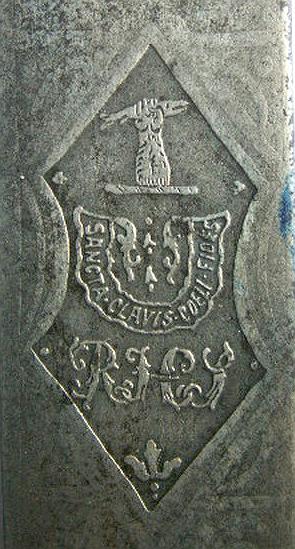
detail of the sword of General Sir Richard Hieram Sankey 1829-1908
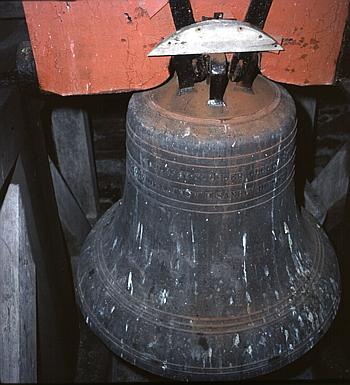
the memorial bell at Colebrooke
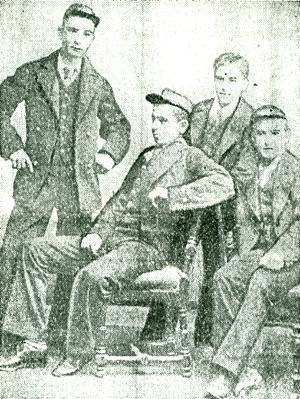
The only known photo of grandfather (at far right) during his sea career
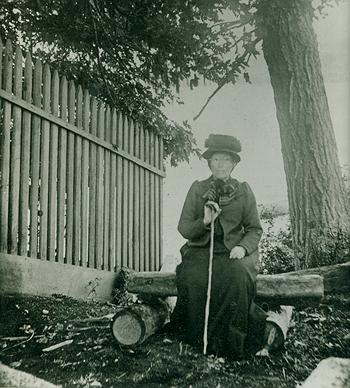
Mehetabel Sankey ca. 1900
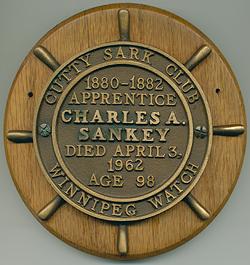
grandfather's memory wheel cast from the sheathing taken off the Cutty Sark in 1955
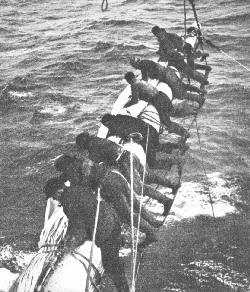
furling a sail
|
